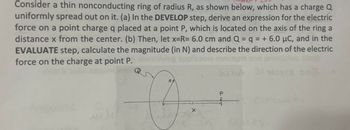
University Physics Volume 2
18th Edition
ISBN: 9781938168161
Author: OpenStax
Publisher: OpenStax
expand_more
expand_more
format_list_bulleted
Question
No Chatgpt please will upvote

Transcribed Image Text:Consider a thin nonconducting ring of radius R, as shown below, which has a charge Q
uniformly spread out on it. (a) In the DEVELOP step, derive an expression for the electric
force on a point charge q placed at a point P, which is located on the axis of the ring a
distance x from the center. (b) Then, let x=R= 6.0 cm and Q = q = + 6.0 μC, and in the
EVALUATE step, calculate the magnitude (in N) and describe the direction of the electric
force on the charge at point P.
boit
فلد
R
P

Expert Solution
This question has been solved!
Explore an expertly crafted, step-by-step solution for a thorough understanding of key concepts.
Step by stepSolved in 2 steps

Knowledge Booster
Similar questions
- A long copper cylindrical shell of inner radius 2 cm and outer radius 3 cm surrounds concentrically a charged long aluminum rod of radius 1 cm with a charge density of 4 pC/m. All charges on the aluminum rod reside at its surface. The inner surface of the copper shell has exactly charge to that of the aluminum rod while the outer surface of the copper shell has the same charge as the aluminum rod. Find the magnitude and direction of the electric field at points that are at the following distances from the center of the aluminum rod: (a) 0.5 cm, (b) 1.5 cm, (c) 2.5 cm, (d) 3.5 cm, and (e) 7 cm.arrow_forwardConsider a thin, spherical shell of radius 14.0 cm with a total charge of 32.0 C distributed uniformly on its surface. Find the electric field (a) 10.0 cm and (b) 20.0 cm from the center of the charge distribution.arrow_forwardIf more electric field lines leave a gaussian surface than enter it, what can you conclude about the net charge enclosed by that surface?arrow_forward
- Determine if approximate cylindrical symmetry holds for the following situations. State why or why not. (a) A 300-cm long copper rod of radius 1 cm is charged with +500 nC of charge and we seek electric field at a point 5 cm from the center of the rod. (b) A 10-cm long copper of radius 1 cm is charged with +500 nC of charge and we seek electric field at a point 5 cm from the center of the rod. (c) A 150-cm wooden rod is glued to a 150-cm plastic rod to make a 300 cm long rod, which is then painted with a charged paint so that one obtains a uniform charge density. The radius of each rod is 1 cm, and we seek an electric field at a point that is 4 cm from the center of the rod. (d) Same rod as (c), but we seek electric field at a point that is 500 cm from the center of the rod.arrow_forwardTwo solid spheres, both of radius 5 cm, carry identical total charges of 2 C. Sphere A is a good conductor. Sphere B is an insulator, and its charge is distributed uniformly throughout its volume. (i) How do the magnitudes of the electric fields they separately create at a radial distance of 6 cm compare? (a) EA EB = 0 (b) EA EB 0 (c) EA = EB 0 (d) 0 EA EB (e) 0 = EA EB (ii) How do the magnitudes of the electric fields they separately create at radius 4 cm compare? Choose from the same possibilities as in part (i).arrow_forwardTwo infinite, nonconducting sheets of charge are parallel to each other as shown in Figure P19.73. The sheet on the left has a uniform surface charge density , and the one on the right hits a uniform charge density . Calculate the electric field at points (a) to the left of, (b) in between, and (c) to the right of the two sheets. (d) What If? Find the electric fields in all three regions if both sheets have positive uniform surface charge densities of value .arrow_forward
- A particle with charge q is located inside a cubical gaussian surface. No other charges are nearby. (i) If the particle is at the center of the cube, what is the flux through each one of the faces of the cube? (a) 0 (b) q/20 (c) q/60 (d) q/80 (e) depends on the size of the cube (ii) If the particle can be moved to any point within the cube, what maximum value can the flux through one face approach? Choose from the same possibilities as in part (i).arrow_forwardThe electric field 10.0 cm from the surface of a copper ball of radius 5.0 cm is directed toward the ball's center and has magnitude 4.0102 N/C. How much charge is on the surface of the ball?arrow_forwardA solid, insulating sphere of radius a has a uniform charge density throughout its volume and a total charge Q. Concentric with this sphere is an uncharged, conducting, hollow sphere whose inner and outer radii are b and c as shown in Figure P19.75. We wish to understand completely the charges and electric fields at all locations. (a) Find the charge contained within a sphere of radius r a. (b) From this value, find the magnitude of the electric field for r a. (c) What charge is contained within a sphere of radius r when a r b? (d) From this value, find the magnitude of the electric field for r when a r b. (e) Now consider r when b r c. What is the magnitude of the electric field for this range of values of r? (f) From this value, what must be the charge on the inner surface of the hollow sphere? (g) From part (f), what must be the charge on the outer surface of the hollow sphere? (h) Consider the three spherical surfaces of radii a, b, and c. Which of these surfaces has the largest magnitude of surface charge density?arrow_forward
- A solid conducting sphere of radius 2.00 cm has a charge 8.00 μC. A conducting spherical shell of inner radius 4.00 cm and outer radius 5.00 cm is concentric with the solid sphere and has a total charge −4.00 μC. Find the electric field at (a) r = 1.00 cm, (b) r = 3.00 cm, (c) r = 4.50 cm, and (d) r = 7.00 cm from the center of this charge configuration.arrow_forwardWhat is the force on the charge q at the lower-right-hand comer of the square shown here?arrow_forwardCan you arrange the two point charges q1=2.0106C and q2=4.0106C along the x-axis so that E=0 at the origin?arrow_forward
arrow_back_ios
SEE MORE QUESTIONS
arrow_forward_ios
Recommended textbooks for you

 Physics for Scientists and Engineers: Foundations...PhysicsISBN:9781133939146Author:Katz, Debora M.Publisher:Cengage Learning
Physics for Scientists and Engineers: Foundations...PhysicsISBN:9781133939146Author:Katz, Debora M.Publisher:Cengage Learning Principles of Physics: A Calculus-Based TextPhysicsISBN:9781133104261Author:Raymond A. Serway, John W. JewettPublisher:Cengage Learning
Principles of Physics: A Calculus-Based TextPhysicsISBN:9781133104261Author:Raymond A. Serway, John W. JewettPublisher:Cengage Learning Physics for Scientists and Engineers, Technology ...PhysicsISBN:9781305116399Author:Raymond A. Serway, John W. JewettPublisher:Cengage Learning
Physics for Scientists and Engineers, Technology ...PhysicsISBN:9781305116399Author:Raymond A. Serway, John W. JewettPublisher:Cengage Learning Physics for Scientists and Engineers with Modern ...PhysicsISBN:9781337553292Author:Raymond A. Serway, John W. JewettPublisher:Cengage Learning
Physics for Scientists and Engineers with Modern ...PhysicsISBN:9781337553292Author:Raymond A. Serway, John W. JewettPublisher:Cengage Learning College PhysicsPhysicsISBN:9781285737027Author:Raymond A. Serway, Chris VuillePublisher:Cengage Learning
College PhysicsPhysicsISBN:9781285737027Author:Raymond A. Serway, Chris VuillePublisher:Cengage Learning


Physics for Scientists and Engineers: Foundations...
Physics
ISBN:9781133939146
Author:Katz, Debora M.
Publisher:Cengage Learning

Principles of Physics: A Calculus-Based Text
Physics
ISBN:9781133104261
Author:Raymond A. Serway, John W. Jewett
Publisher:Cengage Learning

Physics for Scientists and Engineers, Technology ...
Physics
ISBN:9781305116399
Author:Raymond A. Serway, John W. Jewett
Publisher:Cengage Learning

Physics for Scientists and Engineers with Modern ...
Physics
ISBN:9781337553292
Author:Raymond A. Serway, John W. Jewett
Publisher:Cengage Learning

College Physics
Physics
ISBN:9781285737027
Author:Raymond A. Serway, Chris Vuille
Publisher:Cengage Learning